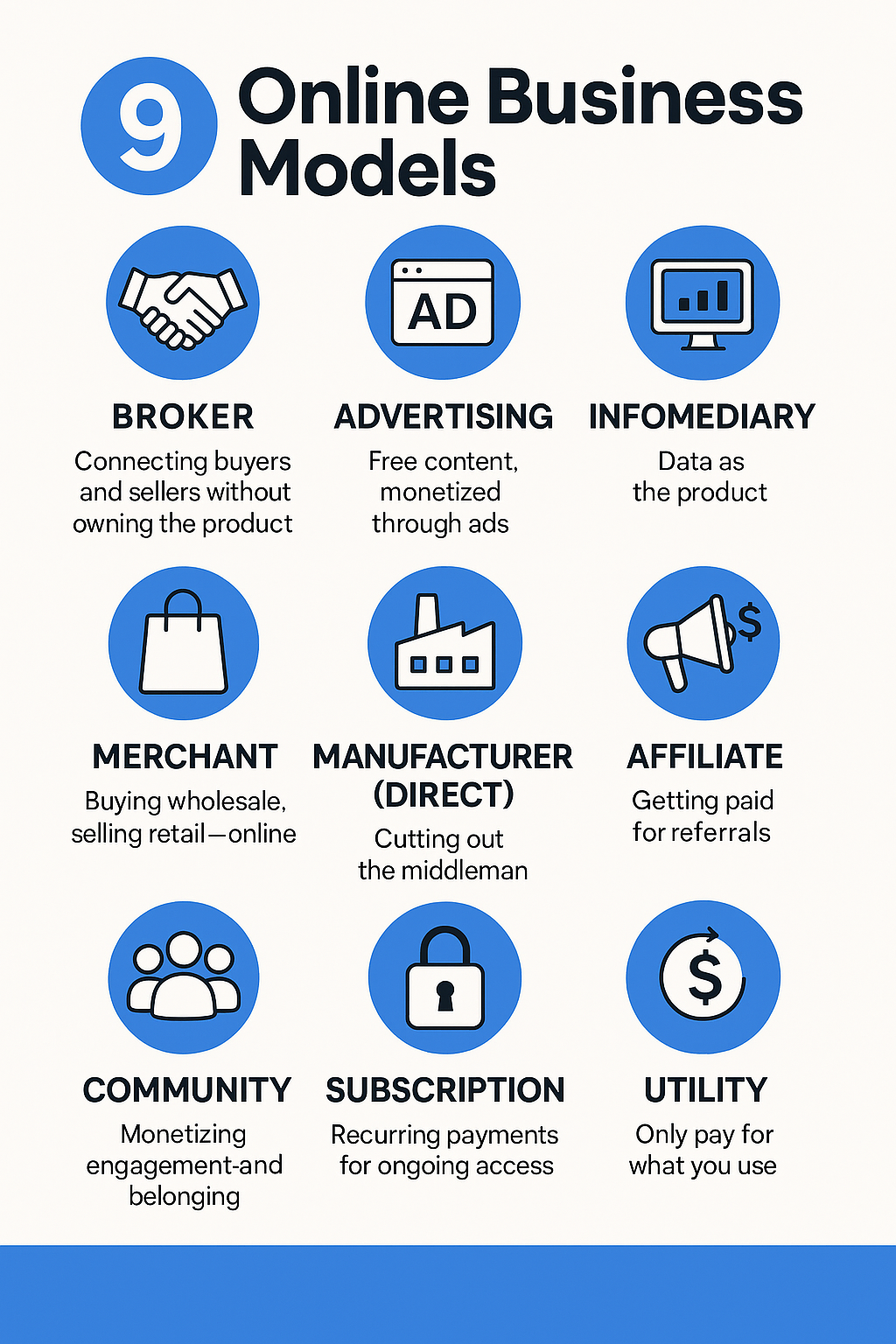Back in the early days of the internet, Michael Rappa (Digital Enterprise) outlined nine online business models that became the foundation of how companies make money online. What’s remarkable is that these models haven’t disappeared—they’ve expanded, merged, and evolved with technology, consumer behaviour, and new platforms.
Let’s revisit them with a modern lens, so you can see how they apply today.
1. Broker Model
Connecting buyers and sellers without owning the product
-
How it works: Brokers act as intermediaries, facilitating transactions between two parties. They don’t own the goods or services; they simply create a trusted platform.
-
Classic Example: eBay.
-
Modern Examples: Airbnb (rooms & experiences), Uber (rides), Fiverr (freelance services), Etsy (handmade goods).
-
Why it matters today: With the rise of the “platform economy,” brokers dominate because they remove friction. Consumers trust the platform to handle payment, disputes, and reviews.
2. Advertising Model
Free content, monetised through ads
-
How it works: Offer free content, tools, or services, then monetise the audience by selling ad space.
-
Classic Example: Google’s search ads.
-
Modern Examples: YouTube (ads before/after videos), TikTok (sponsored content), Meta (Facebook/Instagram ads).
-
New twist: Micro-targeting. Platforms now use AI-driven algorithms to deliver hyper-personalised ads, which makes ad revenue more profitable than ever.
3. Infomediary Model
Data as the product
-
How it works: These companies don’t just connect buyers and sellers; they collect, organise, and sell valuable information.
-
Classic Example: Nielsen ratings.
-
Modern Examples: Experian (credit data), Statista (market data), Google Analytics (audience insights), Similarweb (traffic insights).
-
Future shift: With privacy laws (GDPR, CCPA), infomediaries are under pressure. Consent-based data sharing and “zero-party data” (data customers willingly provide) are the future.
4. Merchant Model
Buying wholesale, selling retail—online
-
How it works: Merchants buy products and resell them to consumers via e-commerce platforms.
-
Classic Example: Amazon (started as books, grew into everything).
-
Modern Examples: Walmart.com, Best Buy, Shein, Shopify stores run by solopreneurs.
-
Trends: Merchants now combine physical + digital strategies (click & collect, AR product previews, subscription boxes).
5. Manufacturer (Direct) Model
Cutting out the middleman
-
How it works: Brands sell directly to consumers (D2C), using e-commerce sites and social platforms instead of wholesalers/retailers.
-
Classic Example: Dell (custom PCs sold online).
-
Modern Examples: Tesla (no dealerships), Apple (stores + online), Warby Parker (glasses), Gymshark (fitness wear).
-
Why it’s booming: D2C allows tighter control of branding, customer data, and margins. Social media + influencer marketing make it easier to reach buyers directly.
6. Affiliate Model
Getting paid for referrals
-
How it works: Affiliates promote a company’s product using links, content, or reviews, earning commission when a sale is made.
-
Classic Example: Amazon Associates.
-
Modern Examples: Influencers promoting products with trackable links, affiliate networks like ShareASale or Impact, bloggers using SEO to drive traffic.
-
Trends: TikTok + Instagram affiliate marketing, AI-powered affiliate content (reviews, comparisons), and niche affiliate communities.
7. Community Model
Monetising engagement and belonging
-
How it works: Communities bring people together around a shared interest, hobby, or mission. Revenue comes from ads, sponsorships, events, or premium memberships.
-
Classic Example: Wikipedia (donations), early Facebook.
-
Modern Examples: Reddit (ads + premium), Discord (Nitro subscriptions), Patreon (paid communities), Substack (paid newsletters).
-
What’s new: Communities are no longer just “nice to have”—they are businesses in themselves. Brands build communities to drive loyalty, referrals, and lifetime value.
8. Subscription Model
Recurring payments for ongoing access
-
How it works: Instead of paying once, customers subscribe for repeated value (monthly, quarterly, yearly).
-
Classic Examples: AOL, early hosting providers.
-
Modern Examples: Netflix, Spotify, Adobe Creative Cloud, SaaS tools (like Notion, Canva, or ClickFunnels).
-
Expansion: Subscription boxes (HelloFresh, Dollar Shave Club) and memberships (Peloton, MasterClass).
-
Why it wins: Predictable recurring revenue = stability. Retention strategies (personalisation, community add-ons) keep users subscribed longer.
9. Utility (Pay-as-you-go) Model
Only pay for what you use
-
How it works: Charges are based on actual usage, not a flat fee.
-
Classic Example: Internet Service Providers.
-
Modern Examples: AWS (Amazon Web Services) cloud hosting, Google Cloud, Azure, Zoom minutes, AI tokens (ChatGPT API).
-
Trend: The rise of micro-transactions in gaming and SaaS. Utility pricing is popular with businesses that scale usage up or down depending on need.
Final Thoughts
Even though these models were defined over 20 years ago, they’re still the backbone of online business today. What’s changed is how flexible they’ve become. Companies often blend multiple models (e.g., YouTube combines advertising, community, and subscription).
👉 If you’re starting an online business, you don’t need to reinvent the wheel. Instead, choose a model—or combination—that fits your strengths, your audience, and your product.


Leave a Reply